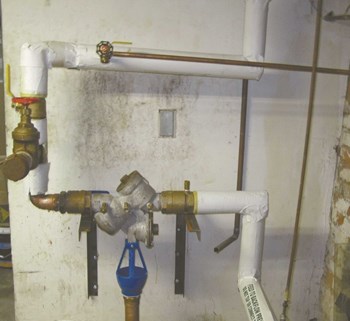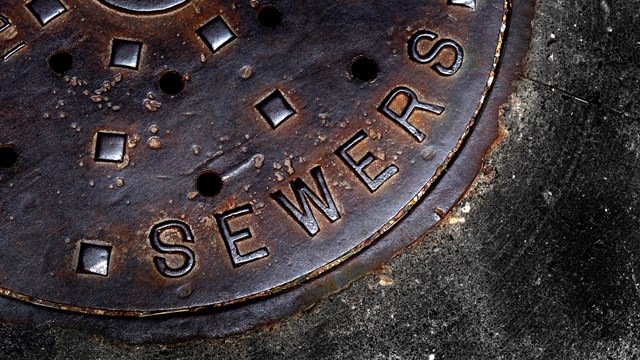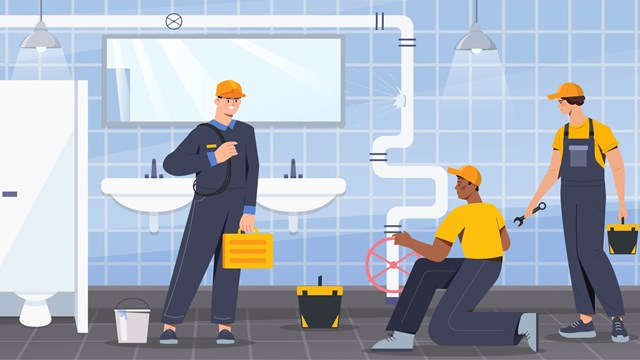
Of all the modern conveniences we take for granted, perhaps none is as essential as indoor plumbing. By carrying fresh water into our homes and taking waste water away, the pipes in our buildings are a little-noticed and well-engineered system that almost magically distances us from our not-too-distant urban past. But when plumbing fails, we almost immediately notice how much we depend upon it.
Savvy city-dwellers know something about their environment—including the building systems upon which they depend. When it comes to plumbing, a co-op or condo resident’s knowledge should go at least a little bit beyond “jiggle the handle until it stops.” Telltale signs of plumbing problems in a building often appear weeks or months before full-on disaster strikes, ending in a very messy cleanup of a burst pipe, for example. Knowing how to detect those potential problems with the building’s plumbing system could mean less money and aggravation expended by all the structure’s residents.
Muddy History
The history of plumbing in New York City is nothing like the tidy, immaculately-tiled bathrooms of some of today’s luxury properties in Manhattan. Just a few generations ago, the city’s water and sewage systems were extremely primitive. In the 1890s, wealthy Manhattan residents may have had septic systems to handle waste, but most homes were still using outhouses. Around that time, the fresh water supply was brought into the residences through wooden and copper piping.
According to Bob Bellini, president of Long Island-based Varsity Plumbing, at the turn of the last century, New York City’s sanitary engineers wanted to eliminate the scourge of cholera, which is largely spread through contact with waste-contaminated water. To accomplish this, they found a way to separate and convey human waste from the city’s water system.
Some of the iron and copper sewer pipes used for those earliest city systems are still in use today, says Stuart Liben, owner of New York City-based Metro Waterworks Inc. “We’ve found sewer pipes that are more than 100 years old. They’re made of extra-heavy cast iron,” he says. “And some old sewer pipes are made of wood.”
The old wooden pipes are actually wooden blocks that had a cylindrical hole drilled through them. But these days, by law, modern pipes which are installed to bring water into city homes must be made of copper or plastic.
Who’s Responsible
Thanks to the antiquated state of the plumbing infrastructure in some of the city’s residential buildings, repairing those systems requires the expertise of highly trained professionals. Repairs of plumbing inside and outside of an apartment can be costly, though. So who is responsible when a pipe inside a wall leaks? Or who pays the bill for repairs when the plumbing in a ceiling fails? The short answer is that the responsibility for plumbing repairs depends upon the building’s governing documents, which vary from building to building.
In many buildings, maintenance of all of the plumbing visible outside of the walls inside an apartment is the responsibility of the apartment owner. Often in such buildings, upkeep of all of the plumbing that is located literally within the walls of the apartment is the bailiwick of the building’s management. Every unit owner should check the building’s bylaws and other governing documents to determine who is responsible for the various parts of the plumbing system.
Sometimes, unit owners must pay for expenses related to maintaining the plumbing inside their apartment walls that connects from the building’s risers to the apartment’s plumbing. "It depends on how the bylaws are written," says Phil Kraus, president and CEO of Manhattan-based Fred Smith Plumbing & Heating.
"Usually in a co-op, the tenants are responsible for what's outside the wall. In condos, sometimes the people are responsible for the piping from the risers through the mainlines out into the bathrooms and kitchens. In a co-op, depending on the lease, it could extend into the walls as well." Kraus emphasizes, "You really have to speak to your managing agent, and read your lease."
The larger a building is, the more intricate the plumbing system will be. A marked difference between plumbing in an average single-family home and a multi-family building is the multi-unit system’s vertical risers. Vertical risers are the large pipes that carry away waste and water from the building. An average single-family home’s vertical riser is a 3-inch pipe compared to a six-story multi-unit’s 6-inch diameter vertical riser or the 8-inch diameter pipe of a 20-story building’s vertical riser.
Larger buildings often need pressure boosters and regulators for their plumbing systems to work properly. These pumping and balancing devices help the system to pipe fresh water up to the building’s higher floors. They also work to provide adequate water pressure. Plumbers access these mechanisms through utility closets on various floors of a building.
Spotting Problems
One of the most common problems associated with plumbing in the city’s multi-family buildings is dirty water, and that is usually a result of water pipe corrosion. Both water and sewage lines wear down over time, and they will often leak when they need to be replaced. Sometimes, the maintenance need will be obvious, due to the water stains on the apartment’s walls or ceiling. Other times, a foul odor could tip off residents to a problem. Sometimes, there are no discernible warning signs of an impending plumbing problem.
Often something seemingly as innocuous as a low-pressure shower or cloudy water from a faucet can be evidence of a much larger not clearly visible problem with the plumbing system. Residents should immediately report to management these or any other plumbing inconsistencies that they notice. Other problems that are just as plainly visible will be recognized to an observant person who knows what to look for. “If a resident sees leaks, staining on the walls or ceiling, or notices the ceiling starting to buckle, the tenant should call the building superintendent immediately,” says Elliot Clark, president at Sanitary Plumbing & Heating in Manhattan.
Since most building superintendents are not plumbers, the professionals say they should never attempt more than simple repairs to the building’s plumbing system. Supers should be able to deal with clogged toilets or stopped-up sink and shower drains. They also can do minor repairs to faucet and water lines (like replacing washers), and can replace sinks and usually—though it’s not always legal—they also can replace toilets. Today though, even these seemingly straightforward repairs have become more complicated.
"A lot of people have installed foreign-made faucets and you need special tools to make these repairs and a lot of the [new] toilets are difficult to work on," says Kraus. Depending on the kind of fixtures installed it’s best to leave the more technical plumbing work to the registered plumbers. To do otherwise would be courting legal and liability issues—not to mention issues of safety.
For example, “A super should never touch any gas piping. They are not registered plumbers,” Clark says.
According to the law, says Bellini, building superintendents are permitted to work on any plumbing on the fixture side—though he points out that many residents ask these building employees to do more than they should.
“The problem is people want to save money, but with plumbing repairs, far too often they bite off more than they can chew [by having a superintendent attempt to do the work],” Bellini says. And, some of the mistakes a super could make, might even be harmful to residents’ health, he adds. “A non-professional might use lead to solder pipes that supply drinking water—but you don’t want lead poisoning do you?”
One recently mandated water and sewer system upgrade, required of all residential buildings in the city, involves installation of backflow preventers. These devices are being required in buildings to prevent a building’s drinking water from flowing back into the city’s main system. "It keeps the water inside the building and prevents it from going back to the street and contaminating the [drinking] water," explains Kraus. Building owners bear the cost of installing these devices. “These devices go on the mainline of the building and can be quite costly, they can cost from $5,000 to $80,000 and more,” says Kraus. Though it is expensive, everyone in the city benefits from these installations.
Can We Talk About It?
Plumbing fixtures and piping are man-made materials and will fail at some point, but residents can work to control how much disruption such failures will cause a building’s residents by keeping their eyes open and not being afraid to invite their superintendent or a plumber into their apartment to fix it. The biggest factor in heading off plumbing pitfalls is adopting a preventative mindset. So when a bathtub is leaking, for example, a unit owner should recognize that failing to fix the problem could lead to pricier repairs and even cause damage to the building’s structure.
When it comes to plumbing emergencies in a multi-unit residential building, failing to report little problems in a timely manner never helps anyone and nearly always results in something larger and more expensive. Bellini says that such delayed fixes can take more time to complete and also can affect every resident’s bottom line by increased maintenance fees needed to pay for the work.
Prevention is also a matter of avoiding daily pitfalls that many city residents succumb to without ever considering the impact they are having on the building’s plumbing system.
“Nobody wants to be inconvenienced by a professional coming out," Bellini continues. “Yet, people want to save money on dry cleaning and so they pour hot water down the drain by running their shower to steam their clothing. But every time water flows down the drain it wears on the piping.”
Keeping eyes and lines of communication open between neighbors and building maintenance staff, co-op and condo residents can prevent little nuisances from turning into huge headaches—and building staff and administrators can do their part as well by educating residents and knowing when to call in a professional.
Jonathan Barnes is a freelance writer and a frequent contributor to The Cooperator and other publications.






3 Comments
Leave a Comment